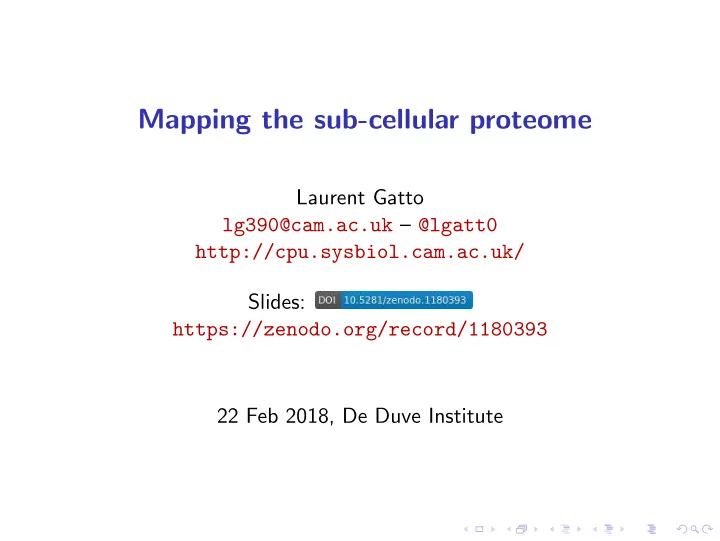

Mapping the sub-cellular proteome Laurent Gatto lg390@cam.ac.uk – @lgatt0 http://cpu.sysbiol.cam.ac.uk/ Slides: https://zenodo.org/record/1180393 22 Feb 2018, De Duve Institute
Take home messages 1. Protein sub-cellular localisation: available technologies and opportunities. 2. Reliance on computational biology to acquire reliable biological knowledge.
Regulations
Cell organisation Spatial proteomics is the systematic study of protein localisations. Image from Wikipedia http://en.wikipedia.org/wiki/Cell_(biology) .
Spatial proteomics - Why? Localisation is function ◮ The cellular sub-division allows cells to establish a range of distinct micro-environments, each favouring different biochemical reactions and interactions and, therefore, allowing each compartment to fulfil a particular functional role. ◮ Localisation and sequestration of proteins within sub-cellular niches is a fundamental mechanism for the post-translational regulation of protein function. Re-localisation in ◮ Differentiation stem cells. ◮ Activation of biological processes. Examples later.
Spatial proteomics - Why? Mis-localisation Disruption of the targeting/trafficking process alters proper sub-cellular localisation, which in turn perturb the cellular functions of the proteins. ◮ Abnormal protein localisation leading to the loss of functional effects in diseases (Laurila and Vihinen, 2009). ◮ Disruption of the nuclear/cytoplasmic transport (nuclear pores) have been detected in many types of carcinoma cells (Kau et al., 2004). ◮ Sub-cellular localisation of MC4R with ADCY3 at neuronal primary cilia underlies a common pathway for genetic predisposition to obesity (Siljee et al., 2018).
Spatial proteomics - How, experimentally Population level Single cell direct Subcellular fractionation (number of fractions) observation 2 fractions n continuous fractions n discrete 1 fraction (enriched fractions (gradient approaches) and crude) GFP Invariant Pure Subtractive LOPIT PCP Epitope rich fraction proteomics (PCA, (χ ) 2 Prot.-spec. fraction catalogue (enrichment) PLS-DA) antibody (clustering) Cataloguing Relative abundance Tagging Quantitative mass spectrometry Figure : Organelle proteomics approaches (Gatto et al., 2010)
Fusion proteins and immunofluorescence Figure : Targeted protein localisation. Example of discrepancies between IF and FPs as well as between FP tagging at the N and C termini (Stadler et al., 2013).
Spatial proteomics - How, experimentally Population level Single cell direct Subcellular fractionation (number of fractions) observation 2 fractions n discrete n continuous fractions 1 fraction (enriched fractions (gradient approaches) and crude) GFP Invariant Pure Subtractive LOPIT rich PCP Epitope fraction proteomics (PCA, (χ ) 2 Prot.-spec. fraction catalogue (enrichment) PLS-DA) antibody (clustering) Cataloguing Relative abundance Tagging Quantitative mass spectrometry Figure : Organelle proteomics approaches (Gatto et al., 2010). Gradient approaches : Dunkley et al. (2006), Foster et al. (2006), based on works by de Duve, Claude and Palade. Explorative/discovery approaches , steady-state global localisation maps .
Cell lysis Fractionation/centrifugation e.g. Mitochondrion Quantitation/identi fi cation by mass spectrometry e.g. Mitochondrion
Quantitation data and organelle markers Fraction 1 Fraction 2 . . . Fraction m markers p 1 q 1,1 q 1,2 . . . q 1,m unknown p 2 q 2,1 q 2,2 . . . q 2,m loc 1 p 3 q 3,1 q 3,2 . . . q 3,m unknown p 4 q 4,1 q 4,2 . . . q 4,m loc i . . . . . . . . . . . . . . . . . . p j q j,1 q j,2 . . . q j, m unknown
Data analysis ◮ Visualisation (cluster, unsupervised learning) ◮ Classification (supervised learning) ◮ Novelty detection (semi-supervised learning) ◮ Data integration (transfer learning) ◮ . . . To uncover and understand biology
Visualisation Correlation profile − ER Correlation profile − Golgi Correlation profile − mit/plastid 0.6 0.5 0.4 0.5 0.4 0.3 0.4 0.3 0.2 0.3 0.2 0.1 0.2 0.1 11 11 11 1 2 4 5 7 8 12 1 2 4 5 7 8 12 1 2 4 5 7 8 12 0.0 Fractions Fractions Fractions Correlation profile − PM Principal component analysis 0.35 0.30 5 0.25 ● ● 0.20 ● ● ● ● ● ● ● ● 0.15 ● 11 0 ● 1 2 4 5 7 8 12 ● ● ● ● ● Fractions ● ● ● PC2 ● ● ● Correlation profile − Vacuole 0.6 −5 0.5 ● ● ER vacuole 0.4 ● ● Golgi ● marker mit/plastid PLS−DA 0.3 PM unknown 0.2 −10 −5 0 5 11 0.1 1 2 4 5 7 8 12 PC1 Fractions Figure : From Gatto et al. (2010), Arabidopsis thaliana data from Dunkley et al. (2006)
Recommend
More recommend